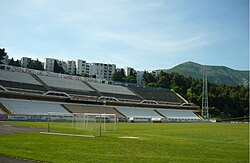 Stadion pod Bijelim Brijegom - UEFA | |
 | |
| Full name | Stadion pod Bijelim Brijegom |
|---|---|
| Location | Mostar, Bosnia and Herzegovina |
| Coordinates | 43°20′44″N 17°47′43″E / 43.34556°N 17.79528°E |
| Public transit | Mostar Bus or Taxi |
| Owner | City of Mostar |
| Operator | HŠK Zrinjski Mostar |
| Capacity | 13,000 (planned under renovation) |
| Field size | 105 m × 70 m |
| Surface | Hybrid grass |
| Scoreboard | LED |
| Construction | |
| Broke ground | 1947 |
| Built | 1956–1958 |
| Opened | 7 September 1958[1] |
| Renovated | 2023–2024 |
| Construction cost | YUD140 million (1958) |
| Tenants | |
| FK Velež Mostar (1958–1992) HŠK Zrinjski Mostar (1992–present) | |
Stadion pod Bijelim Brijegom (English: Bijeli Brijeg Stadium), also known as HŠK Zrinjski Stadium, is a City of Mostar owned association football stadium, located in the city of Mostar, Bosnia and Herzegovina. The venue is currently home of HŠK Zrinjski Mostar. Today it has a capacity of 9,000 seats. Currently, its stadium is being renovated, where instead of standing, there will be a modern new stand for a minimum of 5,000 seats
Location
[edit]The stadium is situated in the city's center, in the neighborhood of Bijeli Brijeg, on the west bank of the Neretva river.
History
[edit]The stadium was built in 1958 with the public subsidies, and volunteering construction works by all denizens of Mostar, particularly students,[2] and it served as the home ground of Velež Mostar during SFR Yugoslavia era.[3][4] During the Bosnian War, between 1992 and 1995, and in particular subsequent incitement of Croat-Bosniak hostilities, the city of Mostar was effectively split to two parts, western (Croat) and eastern (Bosniak), divided around the river Neretva and the city boulevard. The stadium sustained heavy damage during the war, while conflicting ideologies and interests were conveyed from the war times into the post-war era, evidenced in continuous and steady political divisiveness in the city of Mostar, among other, in issues of territorial and ownership disputes. Such political ambiance showed in the forced eviction of FK Velež Mostar from its traditional home-ground of stadium Pod Bijelim Brijegom, and subsequent political and public disputes over stadium usurpation by another club,[4] emerging in the city at the beginning of the war in 1992, namely HŠK Zrinjski Mostar, one of three city's ethno-national football organizations banned by the former Yugoslav government immediately after the World War II. From that moment onward stadium serves solely as the home ground of Zrinjski Mostar.[5]
FK Velež Mostar used stadium Pod Bijelim Brijegom from the time it was built until 1992, through the club's glory days, when they emerged triumphant from their campaigns in the 1981 and 1986 Yugoslav Cups competition, and before that when the club also reached the quarter-final stage of the 1974–75 UEFA Cup.[6][3] People around Velež Mostar club, supporters, as well as aficionados of this cult club around former Yugoslavia, public figures, including number of Croatian intellectuals, continuously advocate for Velež's return to its original stadium,[4] however, so far these calls fall on deaf ears with the city's administration, who often citing political and security issues to continue blocking of Velež's return. The club currently plays at the Rođeni Stadium which was built in 1995.[3][4][7][6]
Importance
[edit]Bijeli Brijeg is the fourth largest stadium in Bosnia and Herzegovina, after Koševo stadium in Sarajevo. The club HŠK Zrinjski administration changed the stadium name into Stadion HŠK Zrinjski (English: HSK Zrinjski Stadium) and registered it with the Football Federation of Bosnia and Herzegovina for the club's games under the association's auspices.[8]
Gallery
[edit]-
View onto field and central Mostar
-
Lower western stands of stadium
-
Pitch and eastern stands (also known as Standing - Croatian: Stajanje)
-
Building of board HŠK Zrinjski Mostar
References
[edit]- ^ "Rođeni se prisjetili otvaranja stadiona Pod Bijelim brijegom i pobjede nad Željom". klix.ba. Retrieved 5 April 2020.
- ^ "Izgradnja gradskog stadiona pod Bijelim Brijegom". Mostarski Rođeni (in Bosnian). 7 April 2017. Retrieved 8 March 2019.
- ^ a b c "Velež treći put pravi stadion, prvi put vlastiti". Al Jazeera Balkans (in Bosnian). 4 November 2017. Retrieved 4 April 2019.
- ^ a b c d "Hrvatski intelektualci poručuju: Vratite Veležu stadion, Mostar bez Rođenih pod Bijelim Brijegom nije Mostar". Tacno.net (in Serbo-Croatian). 17 March 2015. Retrieved 9 May 2019.
- ^ "More Than A Game: How the Mostar derby illustrates Bosnia-Herzegovina's divisions". FourFourTwo. 1 November 2013. Retrieved 9 May 2019.
- ^ a b "FOTO retrovizor: Samo je domaćin Velež obarao kapacitet Bijelog brijega". Sportske.ba (in Bosnian). Retrieved 8 March 2019.
- ^ "Evo kako je izgledala proslava titule Zrinjskog: 'Nismo mi srušili Stari most!'". Slobodna Dalmacija (in Croatian). Retrieved 9 May 2019.
- ^ Giordano Merlicco, Danilo Kovač, Luca Alteri (2023). Competing for the Nation on the Football Pitch: Ideology and Sports in Mostar, in Football in the Balkans I: Internal Views, External Perceptions, eds. D. Wojtaszyn, M. Melichárek. Peter Lang. pp. 101–29.
{{cite book}}: CS1 maint: multiple names: authors list (link)
External links
[edit]- Official website (in Croatian)



